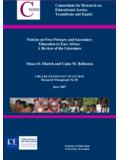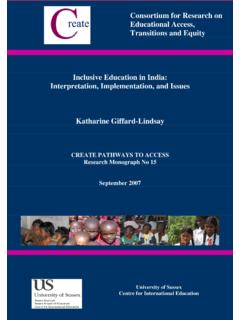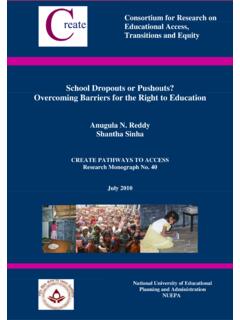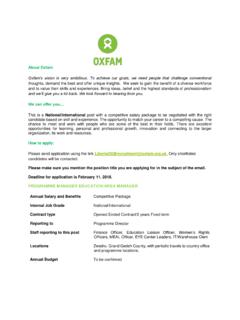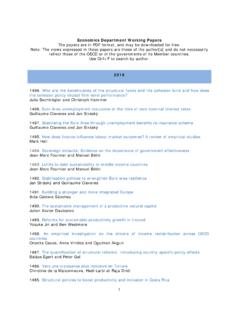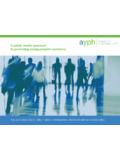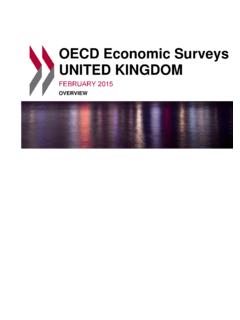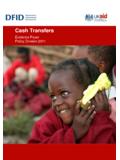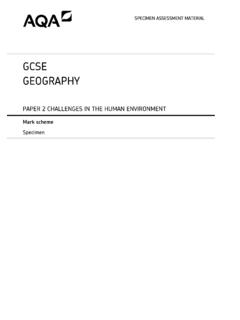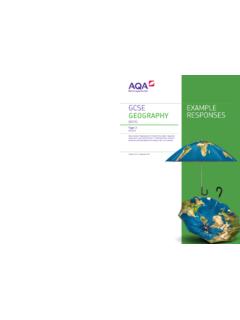Transcription of Education in slums of Dhaka, Bangladesh - create …
1 Education in slums of dhaka , BangladeshPaper prepared for the 10thUKFIET International Conference on Education andDevelopment, 2009 Stuart CameronAbstractDuring the 1990s and early 2000s, Bangladesh experienced strong urban economic growth,a reduction in poverty rates, and rapid growth in primary school enrolments. Amongst manyfactors, these changes are linked to Bangladesh s growing involvement in the globaleconomy, especially in the form of garment factories, and conscious efforts by itsgovernment to increase enrolments through its primary Education plans.
2 This paperdescribes the results from research in the slums of dhaka . Although nominally richer andgeographically closer to urban job markets than those in rural areas, people in the slums ofDhaka have greater difficulty accessing schooling, and have questionable rewards to lookforward to at the end of it. The study draws on the theory of rates of return to Education , butalso looks beyond that to consider the factors that impede households from accessing thefinancial and other rewards that supposedly accrue from Education . In particular, socialconnections play an important role in getting jobs and realizing other opportunities; and,unsurprisingly, gender plays a decisive role in deciding boys and girls futures.
3 Although theresearch uncovered some potential routes through which schooling could reduce poverty,these were not realistically attainable in many cases. The paper considers these results inthe light of human and social capital theories and ideas about the reproduction of socialclass through is based on my doctoral research, and research conducted for the create programme,on Education in slums of dhaka , Bangladesh , conducted in the summer of2008. The researchis abouthow families in slums make decisions about schooling, howthese decisions related to their economic, social and migration background, and to theiraspirations and expectations concerning their children s approachis broadlyderived from the economics of returns to Education , andassumes that parents and childrenmake rational decisions about whether or not a child will go to school and for how long.
4 Butitleaves asquestionsexactly who makes those decisionsand on the basis of acknowledges that parents can not see very clearly what kind of benefitsthere might be to having an Education in 10 years time,although they can make to take into account the ways that families useexistingphysical, humanand social capitalto improve the prospects of the next generation. But it admits thatinvestments in Education and social connections by one family could have negative, as wellas positive, implications for of:-A survey of 400 households in each of four slums in dhaka , covering the age andschooling of each household member and some socioeconomic data.
5 (This surveyhasalso been conducted in several rural areas as part of the create researchprogramme).-A second survey addressed only to families with children aged 11-15and focusing onthe Education decision process, and with further questions about the household seconomic, migration and social of around twenty households aiming to get into furtherdepth about the decision severallimitations. It took place during the day time, when not all parentswere four (large) slums were surveyed; although some attempt was made tochoose four slums with a variety of characteristics (government vs.)
6 Private; well-establishedvs. newer) it cannot be assumed that the results will generalise to all of dhaka s nearly interviews provide more depth than the survey but still only skim the surface ofhow participants really saw their situation and their relation to the Education a strong possibility of response bias in some of the answers, although care was taken toword questions of thequantitativefindings related here draw on self-estimated monthly householdincome data, which may not be very reliable. The intention is to use other indicators ofsocio-economic status (including perceived financial well-being; asset ownership; conditionof dwelling; migration stauts and social connections) for analysis later paper firstsummarisesthe national economicand educationalcontext as told bynational household surveysand drawing on the World Bank s 2008 poverty assessment.
7 Itthenqualifiesthisrelatively optimistic national picture ofpoverty reductionand educationexpansion by drawing on my own and other studies ofurban it considerspolicy implications and highlights some questions that educationalcontextDuring the 1990s and early 2000s, data from national household survey data suggest thatBangladesh has achieved respectable growth in gross domestic product (GDP) combinedwith stable levels of a result, the poverty headcount ratio the proportion ofpeople below a poverty line has declined from 57% at the beginning of the 1990s, to 49%in 2000 and 40% in 2005 (World Bank, 2008).
8 The World Bank credits this success story to increasing labour force participation and educational attainment, especially amongstwomen; urbanization; rising returns to human and physical assets; and rising in dhaka division1is the lowest in the country and also dropped the fastest between2000 and seems to be partly due to people in rural areas finding jobs in the s population is expanding by each year, making it the fastest-growing city in theworld (UN-HABITAT 2008).For the country as a whole, the rural-urban shift accounted for9% of the reduction in poverty between 2000 and manufacturing has been an important component of the country s economicgrowth, particularly in attracting foreign direct investment.
9 The ready-made garment sectoraccounts for about10% of GDP (World Bank, 2009). UNCTAD (2007) highlights theindustry s flexibility in adjusting to unskilled labour, low precision standards and longdelivery times (p. 36) and notes that it can operate at different points along the industry in Bangladesh consists of both local and foreign firms, but the localfirms participate only at the low end of the spectrum, in low-value-added subcontractedactivities (p. 37).There are signs that the garments industry, along with otherexportbusinesses, is about to suffer the effects of the global recession, with adverse consequencesfor jobs and poverty(World Bank, 2009).
10 Women s participation in the labour market, their working hours, level of Education , andincome, haveall increased particularly fast between 2000 and 2005 (World Bank 2008). Buttheir participation in wage work remains very low. Much of the growth in femaleemploymenthas been in urban areas, and much of that in the textile and apparel publicsectorhas also been actively recruiting women, mainly as teachers and health events, particularly the rise in food prices since 2007, floods,and cyclone,have setback some of the reduction in of the food crisishas beenworse for already-poor households, and for vulnerable groups like daily wage workers and the poorest and most vulnerable groups are daily wage labourers, accounting forabout a third of all workers.

